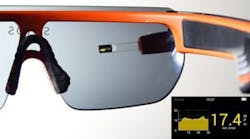Wearables and the ‘New Toolkit for Modern Manufacturers’
Two seconds.
In 1968, an IBM psychologist named Robert B. Miller presented a paper on computation response time at the Fall Joint Computer Conference that focused in part on that passed-in-a-flash stretch of time. Miller had been studying early computer operators for years and — long before the first personal computers, the first laptops, the first tablets, and certainly before the first connected eyeglasses and watches and rings — focused on what he called the “two-second response” theory.
“The tasks which humans can and will perform with machine communication will seriously change their character if response delays are greater than two seconds,” Miller wrote. More simply, we will shake our heads and walk away (or at least say we will) if our various devices fail to deliver what we ask within two seconds. Good thing wearables help cut down on that response time, technologically spoiling us that much more. The next round of wearables will continue the trend.
New hardware and software, some of it delivered at the most recent Consumer Electronics Show earlier this month in Las Vegas, could finally allow our dreams of a wired workforce to become reality. We all know that Google Glass sputtered for the consumer market and is a relative hit for the factory floor, and that Apple Watch has sparked more general interest than any other wearable, with strong potential for industry. There are plenty of other options out there now, though, and the number of choices will continue to climb.
The Daqri Smart Helmet and Kopin Smart Glass, for starters, “have the potential to give manufacturers more choices to support workers with real-time, on-body connectivity to applications and data,” said Plex CTO Jerry Foster, who is at work on new wearables apps for the floor and the warehouse.
“Wearable devices are part of the new toolkit for modern manufacturers,” Foster said, “with cloud solutions making it easy to connect new products and innovation as fast as they hit the market.” Which is a little slower than two seconds, but still really fast.
We are still in the early days of adaptation and implementation, but if this round of products delivers, 2016 really could be the turning point — especially for manufacturers.
Let’s start with the scale of deployments, which could be even more important this year than the technology itself, at least according to Brian Ballard, CEO and co-founder of APX Labs, which has carved its early wearables niche in developing software for some major names in the oil, gas and defense sectors.
“Smart glasses really cemented themselves as something companies were using in 2015, but … it takes almost a year to get through everything,” Ballard said. “You’ll start seeing them used on a much larger scale than they were in 2015: Moving from one line to the whole factory, or from one factory to the whole bullpen of factories that support a process.
“There are still some areas inside logistics that we won’t see — the hardware can’t replace all the tools used today — but in field service and manufacturing, I think you’re going to see a big uptick in the technology.”
Ballard and APX Labs could play a part in that uptick, thanks to another recent round of funding that increased its total raised to $29 million and included considerable investment from General Electric, which is also a customer. (Boeing is another customer, as are two of the five largest companies in the oil and gas industries, though they don’t allow their names to be used.)
“We started off in the defense space,” Ballard said, “building software to power defense-focused wearable technology — almost entirely smart glasses and heads-up displays. … We thought you could eventually do anything and everything on wearable glasses, so we built a flexible, powerful platform, then thought about our feature set in terms of specific verticals.
“If I’m a manufacturer, what are the five or 10 top things every manufacturer has to do? We put a lot of energy into those features, but it has flexibility for a bunch of different use cases.” Among those top 10 things are inspection and compliance, the collection and access of knowledge, and the implementation of an easy-to-use work process.
“The same platform your supervisors are using is the same one your technicians are using and the same one your supply chain is using. It’s a hyper-connected, multi-player work environment,” Ballard said. “We didn’t see this as just a bunch of individual users working together. We saw it as a team working together — with your existing legacy systems, with your robotics, with your IoT — and all that together could be a game-changer.”
What Will We Use? And Who Will Make It?
Glasses might not be the biggest game-changer, though. A recent study from IDC forecasts about 160 million wearables shipped in 2019, with more than 120 million of them headed for your wrist. (For the sake of comparison, about 25 million wearables shipped in 2014, and close to 80 million shipped last year.) Connected glasses, modular and clothing will make up almost all of the remaining quarter.
“A lot of companies will use ergonomic sensors,” including some in clothing, said Rana J. Pratap, principal technology consultant for LexInnova. Why clothing wearables? It’s a safety measure, more than anything else, and “safety is a huge area. I don’t see a lot of wearable applications used just for the heck of it. More will be used for safety, for improving the worker productivity.”
Clothing wearables could be used most prominently to help workers remain visible, especially to, say, forklift drivers, when they would otherwise remain hidden around corners or behind other machines. They could also, Pratap said, help maintain temperature in extreme conditions, though “those applications are more futuristic.”
At least as interesting as what the new wearables will be is who might be manufacturing them. In a new paper titled “Wearable Technology: Patent Landscape Analysis,” LexInnova breaks down which companies have the most current wearable tech patent filings. Smartphone leaders Samsung and Apple do not top the list — ranking fourth and 12th, respectively, with 498 patents and 197 patents, with Fitbit even lower at 15th thanks to its 192 patents. Granted, those companies might have better patents — quality over quantity, which is also measured in the paper — but different companies at the top could open the door to more innovation and competition.
And the top three on that list? Microsoft and Philips, which are neck and neck at 757 and 756 wearable patents, respectively, and Alphabet (which is still just Google for all intents and purposes) at 602.
That number of patents, and the corresponding level of possibility, is exciting. “We’re in the first phase of wearables,” Plex vice president of development Jason Prater said. “In the next five to seven years, as the consumerization continues to drive the innovation, you’re going to see some amazing things. I think this iteration of wearables is going to continue to go faster.
“And even after that,” his Plex partner, CTO Jerry Foster, said, “you’re going to see ingestibles that start to monitor things inside you. That’s fascinating and kind of scary at the same time.” Technology, tracking you, measuring you, telling you about yourself … from your insides.
In a 2013 interview with Wired, Evernote CEO Phil Libin said that wearables will “make you more aware, more mindful. They’ll reduce the number of seconds in the day when you’re confused.” And they will keep you more aware and give you a sense of where you are, whether you wear them on your wrist, your fingers or your eyes, in your clothing … even whether you swallow them first.
“That’s what this whole connected universe will do,” Libin said. “It will make you a functionally smarter human.”
In just two seconds. Or less.




